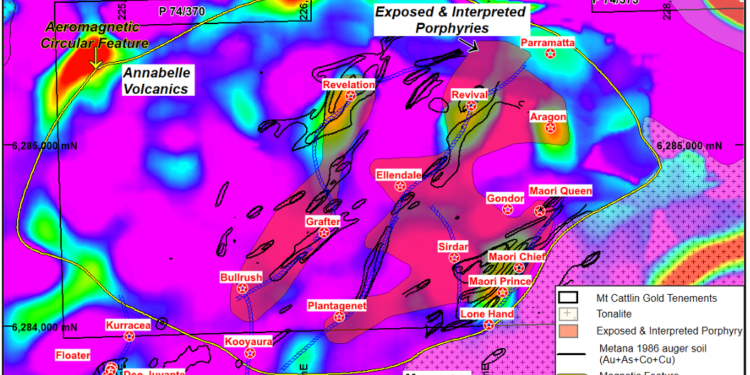Traka Resources Limited (ASX: TKL) is confident recent results have significantly upgraded the discovery potential within its 100%-owned Mt Cattlin Gold-Copper Project, located immediately adjacent to the Mt Cattlin lithium mine in the Ravensthorpe Greenstone Belt in south-west Western Australia.
The results include potential extensions to the existing Mineral Resource at Sirdar, as well as the identification of three buried mineralised intrusives that sit below the existing drill targets but have never been tested by previous drilling.
The Sirdar Prospect: Four RC drill holes were planned to test the down-plunge potential of the Sirdar Deposit (133,186t @ 3.40g/t Au), but only one hole, RAGC088, reached its intended target due to very high ground-water flows.
A diamond drill-hole tail was added to RAGC090 to achieve target depth in a second position to ensure sufficient information was gathered for future drill planning.
Drill-hole RAGC088 intersected mineralisation which appears to highlight a new mineralised hanging wall structure in a position consistent with the expected down-plunge extension of the Sirdar Mineral Resource.
RAGC088 returned a peak intersection of 2m @ 2.59g/t Au including 1m @ 4.61g/t Au from 168m down-hole, with additional wide intercepts of lower-grade mineralisation above and below indicating an extensively mineralised zone.
A previously reported intersection of 1.65m @ 19.20g/t Au including 0.5m @ 47.90g/t Au on drillhole RAGD038 intersected this structure at depth. A reorientation of drilling would be required to test this structure in future.
Drillhole RAGD090 intersected gold-copper mineralisation in a number of positions down-plunge from the Sirdar Mineral Resource, with a peak intersection of 0.5m @ 3.04g/t Au and 0.21% Cu from 156m downhole.
The presence of disseminated fine grained sulphides, alteration and mineralisation in this position as well as up- and down-hole account for the IP (Induced Polarisation) geophysical anomaly and confirms that this target remains open at depth.
The individual high-grade shoots that comprise the Sirdar Mineral Resource are relatively small features that will require the remaining drill pattern to be completed to properly evaluate the potential for extensions.
The newly-identified down-plunge extension and mineralised hanging wall structure remains open, with the opportunity to significantly increase the existing Mineral Resource through further drilling.
Mineralised Intrusives
Modelling of new generation low detection limit multi-element geochemical data, in combination with geological review, has indicated the presence of three buried mineralised intrusive bodies within the 3.5km-wide intrusive complex that is centrally located within Traka’s tenements.
These bodies may prove to be the key components of a porphyry and/or intrusive-related gold (IRG) system, the primary centres of mineralisation and an important feeder source for the cluster of near-surface gold and copper targets that have been the focus of Traka’s two most recent drill programmes.
These bodies have never been tested by previous drilling.
The geochemical modelling undertaken utilises low level multi-element pathfinder elements to detect the presence of an alteration halo, always present around large mineralised intrusives, as well as to provide a vector towards its core. The cores of the three intrusive bodies are currently interpreted to lie between 680m and 1,155m depth, with the larger northern body extending vertically to relatively shallow depth.
This is a significant new finding, with in-fill geochemical sampling, geological validation and further modelling now being progressed to achieve higher definition of the intrusive bodies and assist with the design of a drill programme.
The identification of these new mineralised intrusives indicates the potential for a large, multi-phase mineralised intrusive complex with untested bodies at depth. This opportunity has never been tested by Traka’s drilling to date, which remains limited to near-surface peripheral mineralisation.
The near-surface mineralisation positions – such as the Mineral Resources at Sirdar and Maori Queen (22,940oz @ 3.94g/t Au), the kilometre long mineralised zones highlighted between Ellendale and Plantagenet, between Maori Queen and Lone Hand and other prospects like Grafter and Revelation – already provide considerable value to the project.
Managing Director, Patrick Verbeek, said that with the exception of Sirdar, these mineralised positions are all located within late-stage structures dissecting the intrusive complex and acting as conduits to remobilised mineralised fluids or are associated magnetite and garnet-rich skarns on the periphery of individual intrusive bodies making up the complex.
The Sirdar Mine is directly above one of the buried intrusives and this may account for the unique nature of this Mineral Resource compared to the others. Sirdar is in an aeromagnetic low zone and is coincident with a chargeability IP anomaly, whereas the other targets are within or close to aeromagnetic high zones and area of resistivity.
The identification of the three new intrusives has the potential to dramatically redefine the exploration strategy at Mt Cattlin, with the Company now undertaking additional modelling to assess this opportunity.
In-fill geochemical sampling to refine modelling of the buried intrusives as well as the Ellendale-toPlantagent line of works has commenced. The results of this work will be used to plan the next drill programme.
“These are hugely encouraging results that provide plenty of impetus for our ongoing exploration programs at Mt Cattlin,” Mr Verbeek said.
“The Sirdar Mineral Resource extends down-plunge and has a new hanging zone, and we now see also sits above one of the newly identified intrusives. We will plan additional drill holes to test this potential once current follow-up surveys are complete.
“The identification of three new buried intrusives is a potential game-changer at Mt Cattlin, representing the potential heart of a porphyry or intrusive-related mineralised system. “These bodies have never been tested by previous drilling and we are now working to refine our models to include with the next drill programme.”
For further information please visit: https://www.trakaresources.com.au/












